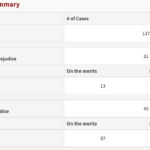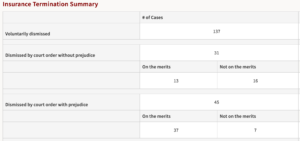Author: Tom Baker Date: 10.23.20
I’ve received a couple of questions about the classification of the Order entered in the SSF II v. Cincinnati decision in Ohio state trial court (Franklin Cty, 20CV-04-002644, Sep. 8, 2020) in our Outcomes table. I’ve been asked why we coded that order as a denial of a motion to dismiss, when, technically, what the judge did was to convert a motion to dismiss into a motion for summary judgment.
My answer is: (1) the Order had the same effect as a motion to dismiss, (2) there are “edge cases” in any coding system that require the exercise of discretion, and (3) we’re working really hard to exercise that discretion in a neutral, fair manner.
As to (1), here’s what the Order did: over Cincinnati’s objection, Judge Holbrook converted Cincinnati’s motion to dismiss into a motion for summary judgment, delayed any discussion of the briefing schedule on the motion for a month and a half, and allowed discovery to proceed. That’s precisely the procedural effect of a denial of a motion to dismiss.
The evidence of (3) is that we coded Malaube v. Greenwich Ins. Co. (S.D. Florida, 20-22615-Civ-WILLIAMS/TORRES, Aug. 26, 2020) as granting a motion to dismiss, even though what happened in the case was (a) the magistrate judge recommended that the motion be granted and (b) the plaintiff subsequently dropped the case. Technically, that’s not the granting of a motion to dismiss. But, Magistrate Judge Torres took the time to write a lengthy, thoughtful opinion explaining why the motion to dismiss should be granted, and the plaintiffs’ dropping of the case suggests that they were pretty sure that Judge Williams would agree. So, given the choice between leaving Malaube off the list and including it, we included it.
The larger point here is part (2) of my answer. No classification system can ever capture the complexity the world throws at us. To make it possible to observe the big picture, we cannot help but simplify some of the fine details. Speaking for the CCLT team, we do that with humility, always open to being persuaded to do things another way.

 Apologies for the small size (we’re working on adding this in dynamic form to the CCLT website), but what the snapshot shows is that 137 cases have been voluntarily dropped, most often before a response to a motion to dismiss is due, 45 case have been dismissed with prejudice, and 31 cases have been dismissed without prejudice. My impression (not thoroughly checked) is that all of the dropped cases are business interruption cases. That means that more than 15% of the business interruption cases in our database no longer are active.
Apologies for the small size (we’re working on adding this in dynamic form to the CCLT website), but what the snapshot shows is that 137 cases have been voluntarily dropped, most often before a response to a motion to dismiss is due, 45 case have been dismissed with prejudice, and 31 cases have been dismissed without prejudice. My impression (not thoroughly checked) is that all of the dropped cases are business interruption cases. That means that more than 15% of the business interruption cases in our database no longer are active.






